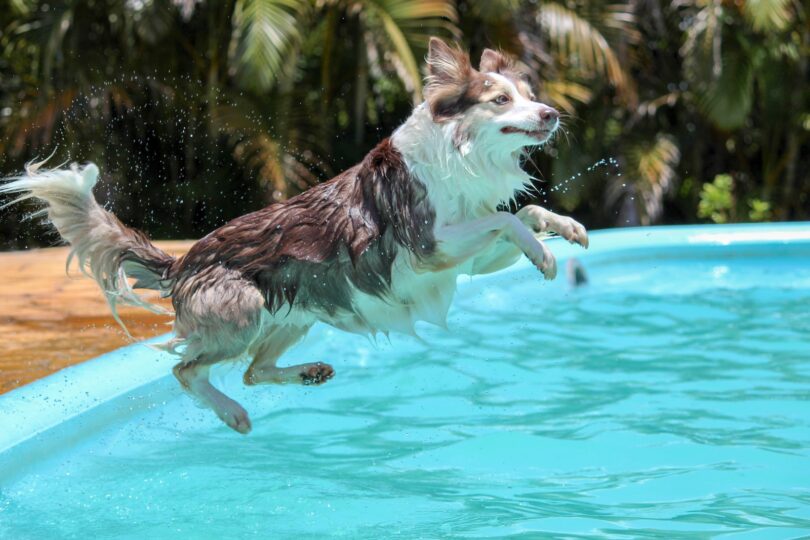Cooling your dog during the summer is very crucial. It is not just important for dogs to drink plenty of water to stay cool, but many dogs love to swim too! Swimming is an excellent exercise option and can prevent your pet from overheating.
Certain breeds, such as spaniels and retrievers will be water-loving naturals. Other breeds such as bulldogs or dachshunds aren’t designed that allow swimming, therefore they must always wear life jackets. Be aware that not every dog will be a great swimmer. Some dogs are too afraid to swim in the water even on a scorching day in summer. In these instances, it’s best to follow your dog’s preference. We’ll provide some suggestions for training the dog how to swim. We’ll also provide information on water safety and health.
Teaching Your Dog How to Swim

Start by playing with your pet in a shallow space such as a child’s pool. This exposes your pet to the water within a secure setting and also shows the dog that it’s an enjoyable game. Next, introduce your pet to a bigger body of water, which is in the majority of cases it’s a pool.
If you walk in the water, most dogs follow, rather than being left on their own. It is also possible to utilize a lead to get your dog to follow you. You can also reward your dog for every step you take into the water. Do not over-excite your dog. It could require several trips before swimming. In the end, when your dog becomes more at ease in the water, you’ll be able to go deeper. Although the dog’s natural instinct will be to begin paddling in deep water, you should wear an inflatable life jacket to protect yourself as a measure. When your dog begins to paddle ensure that you are using the four legs to prevent fatigue. You can place an arm underneath the dog’s belly for assistance. If your dog is beginning to panic, get him back into shallow water and allow it dog to relax.
Before you allow your dog access to the swimming pool, make sure that he is able to safely exit the pool. If your dog is thrown into a lake or river and instinctively tells you that he should look around and try to get back out of the spot the dog fell into. This can work for the natural body of water however, in a swimming pool for suburban residents dogs could drown if they take this instinctual behavior. This is why it is crucial for you to teach your dog how he can exit the pool via the stairs, no matter the location he entered. This can be accomplished by repeatedly leaving and entering the pool by stepping down those steps till it becomes a routine.
Dog Water Safety Tips Every Owner Should Know
Even if your dog is adept at swimming it is important to keep him always under the supervision of a life jacket if needed. Like many dogs who play with the Frisbee repeatedly until they are nearly collapsed, Some dogs swim on without realizing how exhausted they are. As opposed to playing with a ball on the ground there is no firm ground to rest on.
5 Essential Water Safety Tips to Keep Your Dog Healthy
Here’s a list of the hazards to swimming that pet owners need to be aware of before they allow their furry family members to take a dip:
- Never let your dog swim unattended. If your dog is swimming in a pool or in the ocean, make sure that they are within reach of you or with a lifeguard.
- Make Sure the Pool is Dog-Friendly. Install a fence around your pool. This will help prevent accidents as well as protect elderly animals as well as handicapped pets from falling down into your pool. Also, ensure there’s an easy means for your pet gets out of the pool should they fall into it. If there’s not a small area of water near the steps of the pool, you might consider buying a dog ramp.
- Be aware of your dog’s time in the pool. Consuming too much water in the pool could upset your dog’s stomach. In addition, chlorine can cause irritation to your pet’s eyes and the respiratory system.
- Be aware of your dog’s activities at sea. If your dog enjoys swimming in the water, ensure that you don’t let him drink the saltwater. A small amount of saltwater could cause diarrhea, but drinking the entire amount could cause death for your pet. When you go to the beach, ensure you have plenty of water for your pet.
- Be aware of fatigue. Playing with your dog on the beach is a great idea however, be cautious that you don’t throw your ball far enough. Even the strongest swimmers humans and canines could be thrown off guard while being in the water.
4 Water Hazards Dog Owners Should Be Aware Of
- When swimming in the ocean your dog might come across the riptide. In a matter of seconds, the dog could be swept out to sea by the current. The dog is smaller, the more challenging the situation could be. A swimming area that is near a lifeguard’s station is always an ideal idea.
- An ear infection is a typical condition in dogs who often swim. They are usually caused by water getting into the ears of dogs while bathing and then not draining correctly. Your vet can prescribe an ear wash to dry and clean your dog’s ears following swimming.
- Leptospira is a deadly pathogen that can be found in some water bodies and lakes. If your dog was in contact with or consumed water from an affected source, he could contract leptospirosis, which can be a severe disease.
- Fishhooks may get stuck in dogs’ paws when they are stepped on, stuck in their mouths, or swallowed.
It can be a relaxing and healthy exercise for dogs, however, it is important to be aware of the possible dangers and follow the proper precautions. Pet Insurance will help you pay for any common ailments that be caused by your dog doing its best to practice canine paddling. From ear infections to ingestion of items, Pets Best can offer peace of peace of.









Leave a Comment